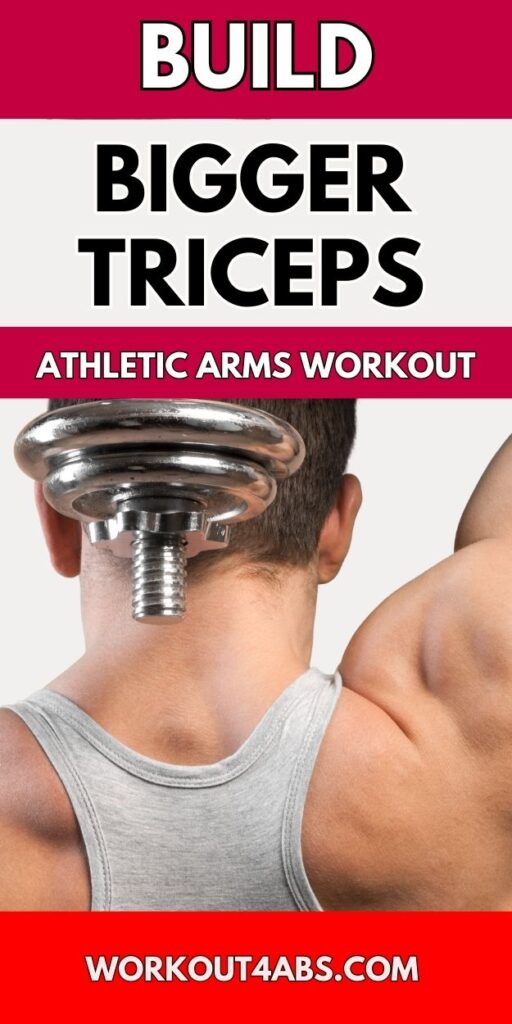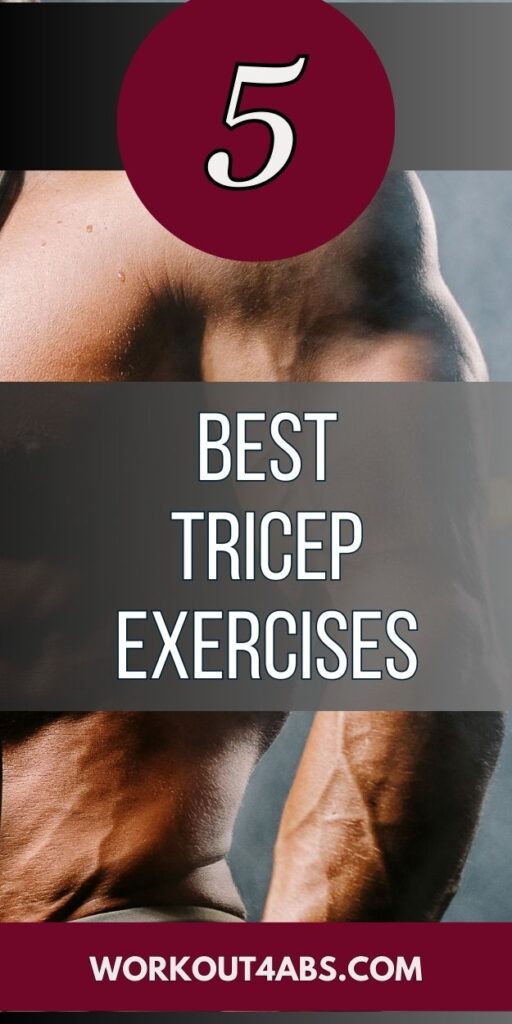Discover the tricep strength workout for increase athletic performance. In the pursuit of enhanced sports performance, building strong and well-developed tricep muscles is a game-changer. This article explores targeted strategies to maximize tricep strength and size, equipping athletes with the power and explosiveness needed to excel in their respective sports. Unlock your athletic potential with these proven techniques.
5 Best TRICEP STRENGTH Exercises For Athletes | BIZE & TRIZE WORKOUT
If you enjoyed these tips, please save this pin to your Pinterest Board.

Training the Triceps for Sports
The triceps brachii, often referred to simply as the triceps, are a group of three muscles located on the back of the upper arm. They play a crucial role in sports that involve elbow extension, particularly during overhead work and pressing movements. Understanding how the triceps are used in sports and how to train them effectively is essential for athletes looking to improve their performance.
- Role of the Triceps in Sports:
- Overhead Work: In sports like tennis, volleyball, basketball, and overhead weightlifting (e.g., snatch or clean and jerk), the triceps are heavily involved in extending the elbow to generate force and control the arm’s movement during overhead actions. These movements often require explosiveness and power to propel an object or control it, which heavily relies on strong triceps.
- Pressing Movements: Sports like football, rugby, and martial arts require pressing actions, such as pushing an opponent or object away. These actions also rely on triceps strength, as the triceps are responsible for extending the elbow during pushing or pressing motions.
- Training the Triceps in Isolated Positions:
- Isolated Exercises: Isolated triceps exercises like triceps extensions (skull crushers, triceps pushdowns) are beneficial for targeting the triceps directly. These exercises allow athletes to focus on strengthening and developing the triceps muscle specifically.
- Benefits: Training triceps in isolation can help improve muscle hypertrophy (increasing muscle size) and overall triceps strength. This can enhance an athlete’s ability to generate force during elbow extension, which is critical in many sports movements.
- Training in Positions Similar to Sports Movements:
- Compound Movements: While isolated exercises are essential for triceps development, it’s equally important to incorporate compound movements that mimic sports-specific actions. Exercises like the bench press, push-ups, and overhead presses engage the triceps while also involving other muscle groups.
- Functional Strength: Training triceps in positions that simulate sports movements helps develop functional strength. It allows athletes to transfer their triceps strength more effectively to their sports, as they are training the muscles in a context that mirrors their actual performance requirements.
- Balanced Training:
- Proportionality: Athletes should strive for a balanced approach to training the triceps. While isolation exercises can help target the triceps directly, compound movements ensure overall strength and functional capability.
- Periodization: Proper periodization of training programs, which includes a mix of isolation and compound exercises, helps avoid overuse injuries and optimizes triceps development.
In summary, the triceps play a vital role in sports involving elbow extension, especially during overhead work and pressing movements. Athletes benefit from both isolated triceps exercises and compound movements that replicate sports actions. A well-rounded training program that addresses both aspects will not only improve triceps strength and size but also enhance sports performance and reduce the risk of injuries.
If you enjoyed these tips, please save this pin to your Pinterest Board.

Seated Dumbbell Tricep Extension
Equipment Needed:
- A dumbbell of an appropriate weight for your fitness level.
Instructions:
- Set Up:
- Sit on a bench or a sturdy, stable chair with a backrest, ensuring your back is firmly supported. Your feet should be flat on the ground, shoulder-width apart.
- Hold a dumbbell with both hands. You can use an overhand grip with your palms facing up, or an alternative grip based on comfort and preference. The dumbbell should be held with both hands close together, vertically, above your head.
- Starting Position:
- Begin with your arms fully extended, and the dumbbell directly above your head. Your elbows should be close to your ears, and your palms should be facing up, as you mentioned, with an open palm grip.
- Execution:
- Slowly lower the dumbbell behind your head by bending your elbows. Keep your upper arms as close to your head as possible throughout the movement.
- Continue lowering the dumbbell until you feel a deep stretch in your triceps. Ensure you maintain control and avoid letting the weight drop quickly.
- Pause briefly at the bottom of the movement, feeling the stretch in your triceps.
- Return to Starting Position:
- Gradually extend your elbows to bring the dumbbell back to the starting position, directly above your head.
- Repetitions and Sets:
- Perform the desired number of repetitions (typically 8-12 reps) and sets (2-4 sets) based on your fitness goals and program.
Tips:
- Choose an appropriate dumbbell weight that challenges your triceps but allows you to maintain proper form and control.
- Focus on the stretch and contraction of your triceps throughout the exercise.
- Keep your core engaged and your back against the bench or chair for stability.
- Avoid using momentum or swinging your arms during the exercise; it should be a controlled movement.
Remember to consult with a fitness professional or trainer if you’re unsure about your form or if you have any underlying medical conditions that may affect your ability to perform this exercise safely.
V Bar Dips to Improve Size and Strength
Performing V-Bar Dips with a slow eccentric (lowering phase) and an explosive concentric (lifting phase) is an effective way to target the triceps and chest muscles while adding intensity to the exercise. V-Bar Dips are typically done using parallel bars shaped like a “V,” and they are an excellent bodyweight exercise for building upper body strength. Here’s how to do V-Bar Dips with the specified technique:
Equipment Needed:
- V-Bar dip bars or parallel bars.
Instructions:
- Setup:
- Stand between the V-Bar dip bars, facing away from them.
- Place your hands on the bars, gripping them with your palms facing each other (the V-bar shape).
- The bars should be shoulder-width apart or slightly narrower.
- Starting Position:
- Lift yourself up, supporting your body on the dip bars. Your arms should be fully extended, and your body should be hanging between the bars.
- Keep your legs straight and your feet off the ground, or you can cross your ankles behind you for stability.
- Eccentric Phase (Lowering):
- Initiate the movement by slowly lowering your body downwards, leaning forward slightly.
- Lower yourself until your shoulders are at or slightly below elbow level. Keep your torso upright and your chest up.
- Maintain a controlled pace during the eccentric phase, taking 2-3 seconds to lower yourself down. This controlled descent will engage the triceps and chest muscles effectively.
- Concentric Phase (Lifting):
- Explosively push yourself back up by extending your arms. Imagine pushing the bars away from you.
- Use the strength of your triceps and chest to lift your body upward. This phase should be done as quickly and powerfully as possible, while maintaining control.
- Fully extend your elbows and return to the starting position.
- Repetitions and Sets:
- Perform the desired number of repetitions, typically 8-12, for 2-4 sets. The slow eccentric and explosive concentric phases will increase the intensity of the exercise.
Tips:
- Maintain proper form throughout the exercise to prevent injury.
- Keep your chest up and shoulders back to engage the chest muscles.
- Focus on breathing. Inhale as you lower yourself (eccentric phase) and exhale as you push back up (concentric phase).
- If you’re new to V-Bar Dips or find them challenging, you can use an assistive machine or have a spotter assist you until you build the necessary strength.
Performing V-Bar Dips with this slow eccentric and explosive concentric technique can help increase muscle strength and power in your triceps and chest, making it an effective upper body exercise.
Cable Extension Working the Triceps
Working the triceps using a cable machine with an overhead position is an excellent way to target and isolate the triceps effectively. This exercise is commonly known as the “Overhead Tricep Extension” or “Cable Tricep Pushdown.” Here’s how to perform it:
Equipment Needed:
- A cable machine with an adjustable pulley system and a high attachment point.
- A straight or rope attachment handle.
Instructions:
- Setup:
- Adjust the cable machine so that the pulley is in the highest position.
- Attach a straight bar or rope handle to the cable.
- Handle Attachment:
- Stand facing away from the cable machine and grab the handle with both hands, palms facing down. Make sure your hands are close together on the handle, forming a diamond shape with your thumbs and index fingers.
- Stance:
- Stand with your feet shoulder-width apart for stability.
- Position yourself a few feet away from the machine to create tension in the cable.
- Starting Position:
- Begin with your arms fully extended overhead, holding the cable handle.
- Keep your elbows close to your head, and your upper arms should be perpendicular to the floor. This is your starting position.
- Execution (Concentric Phase):
- Exhale and, with control, push the handle down by extending your elbows and straightening your arms.
- Focus on using the triceps to perform the movement.
- Continue pushing the handle down until your arms are fully extended, and the cable is just in front of your thighs.
- Squeeze your triceps at the bottom of the movement to maximize the contraction.
- Eccentric Phase (Return):
- Inhale as you slowly allow the handle to rise back up to the starting position, bending your elbows.
- Maintain control during the eccentric phase.
- Repetitions and Sets:
- Perform the desired number of repetitions, typically 8-12, for 2-4 sets.
Tips:
- Keep your core engaged and your back straight throughout the exercise to maintain stability.
- Avoid using your shoulders or back to lift the weight; the emphasis should be on the triceps.
- Use a weight that allows you to complete your desired repetitions with proper form.
- You can vary your grip by using a straight bar or a rope attachment to target the triceps from different angles.
- Focus on a full range of motion, both during the extension and return phases.
- If you feel discomfort in your elbows or shoulders, adjust your grip or the attachment to a more comfortable position.
The overhead cable tricep extension is a versatile exercise that effectively targets the triceps, helping to build strength and size in this muscle group. Include it in your tricep-focused workout routine for well-rounded arm development.
Band Tricep Extension
Equipment Needed:
- A resistance band with handles or a looped band.
Instructions:
- Setup:
- Begin by finding a sturdy anchor point in front of you to attach the resistance band. You can use a door frame attachment, a stationary object, or any secure point at chest height.
- Attachment and Grip:
- Attach the resistance band to the anchor point.
- Stand facing away from the anchor point and hold the band’s handles or loop with both hands.
- Your palms should be facing down, and your hands should be close together, forming a diamond shape with your thumbs and index fingers.
- Stance:
- Stand with your feet shoulder-width apart for stability.
- Starting Position:
- Begin with your arms bent at a 90-degree angle, elbows tucked in close to your sides, and your hands in front of your chest.
- Your forearms should be parallel to the floor, and the resistance band should be taut but not stretched.
- Execution (Concentric Phase):
- Exhale and extend your elbows, pushing your hands backward and away from your body.
- Focus on using the triceps to perform the movement.
- Continue extending your arms until they are fully straight, and your hands are behind your body, parallel to the floor.
- Hold and Squeeze:
- At the fully extended position, pause for a moment and squeeze your triceps to maximize the contraction.
- Eccentric Phase (Return):
- Inhale as you slowly return your hands to the starting position, bending your elbows.
- Maintain control during the eccentric phase.
- Repetitions and Sets:
- Perform the desired number of repetitions, typically 8-12, for 2-4 sets.
Tips:
- Keep your core engaged and maintain good posture throughout the exercise.
- Ensure that the resistance band is securely attached to the anchor point to avoid accidents.
- Use a resistance band with an appropriate level of resistance to challenge your triceps but maintain proper form.
- Focus on a full range of motion, both during the extension and return phases.
- Avoid using your shoulders or back to lift the band; the emphasis should be on the triceps.
- You can vary the resistance by adjusting your grip on the band or using a band with different resistance levels.
This tricep extension exercise using a resistance band is a convenient and effective way to target and strengthen your triceps muscles. It’s suitable for home workouts or when you have limited access to gym equipment.
Bench Press When Triceps are Fatigued
Performing bench presses after fatiguing the triceps can be an effective strategy to promote greater muscle growth and strength in the triceps for several reasons:
- Pre-Fatigued Triceps Targeting: When you perform triceps-focused exercises before bench pressing, your triceps are already in a pre-fatigued state. This means they are more likely to be the limiting factor during the bench press. As a result, your triceps will receive more targeted stress during the compound exercise.
- Increased Time Under Tension: Pre-fatiguing the triceps means that they are engaged from the beginning of the bench press set. This leads to an increased time under tension for the triceps throughout the entire set, which is a key factor for muscle growth. More time under tension typically results in greater muscle fiber recruitment and hypertrophy.
- Enhanced Mind-Muscle Connection: Pre-fatiguing the triceps can help establish a stronger mind-muscle connection with the triceps. You’ll be more aware of the triceps’ involvement during the bench press, allowing you to concentrate on contracting and working the triceps effectively.
- Overcoming Plateaus: If you’ve reached a plateau in your bench press progress, pre-fatiguing the triceps can help break through that plateau. By placing more emphasis on the triceps, you may be able to push through previous strength barriers and stimulate further muscle growth.
- Variation and Muscle Confusion: Incorporating different training techniques like pre-fatiguing the triceps before bench pressing introduces variety to your workout routine. This variation can prevent your muscles from adapting too quickly to the same stimulus, potentially leading to better gains in strength and size.
How to Implement Pre-Fatigue for Triceps:
- Start your workout with isolation exercises specifically targeting the triceps. Exercises like tricep pushdowns, skull crushers, or tricep dips are effective choices.
- Perform 2-4 sets of these triceps-focused exercises, aiming for a high level of fatigue. You should feel a burning sensation and muscle fatigue in your triceps.
- After completing the isolation exercises, proceed to the bench press. Your triceps will already be fatigued from the earlier work.
- During the bench press, ensure you maintain proper form and focus on engaging your triceps throughout the movement. Emphasize the triceps as the primary mover during the lift.
- Continue to progressively increase the weight and intensity of both the triceps exercises and bench presses over time to stimulate continuous growth and strength gains.
It’s important to note that while pre-fatiguing the triceps can be a valuable strategy, it should be incorporated strategically and not in every workout. Periodization and varying your training methods are crucial for long-term progress and to avoid overtraining or injury. Consulting with a fitness professional or trainer can help you create a well-structured workout plan that incorporates pre-fatigue techniques safely and effectively.
If you enjoyed these tips, please save this pin to your Pinterest Board.

Home › Workout for Athletes ›Tricep Strength Workout